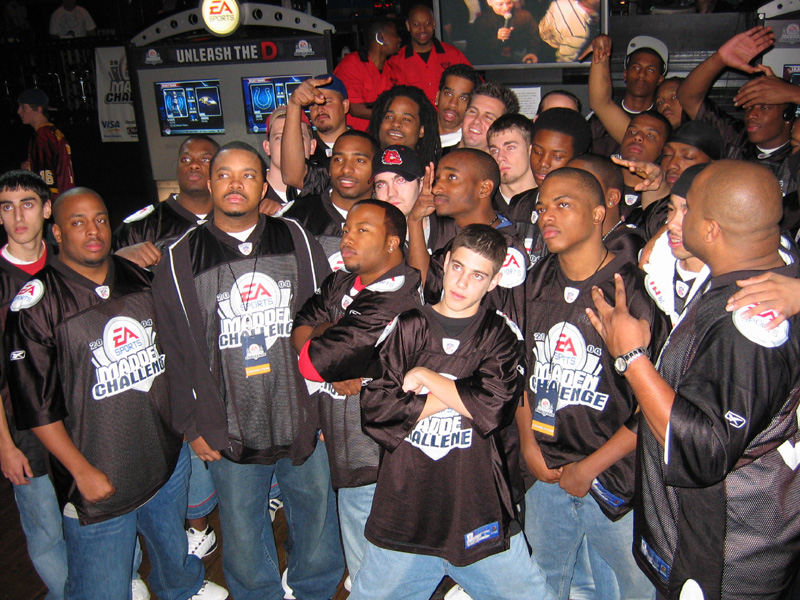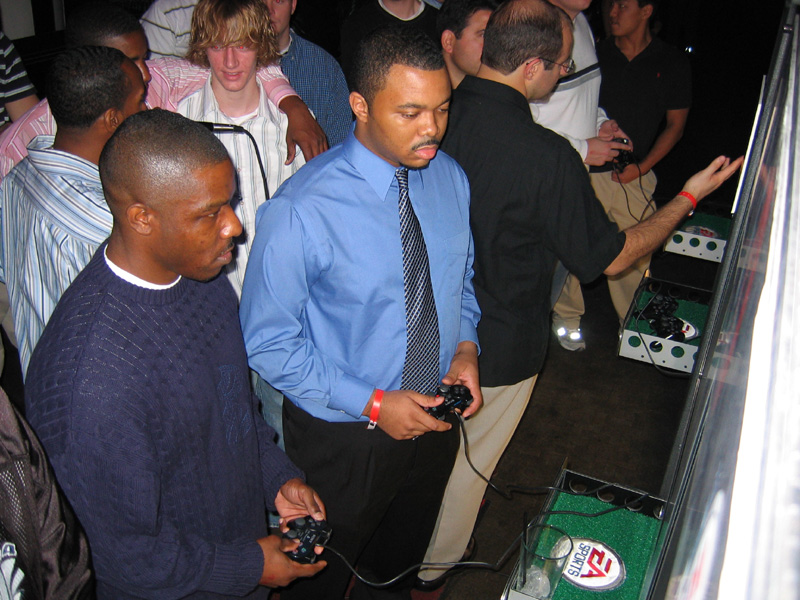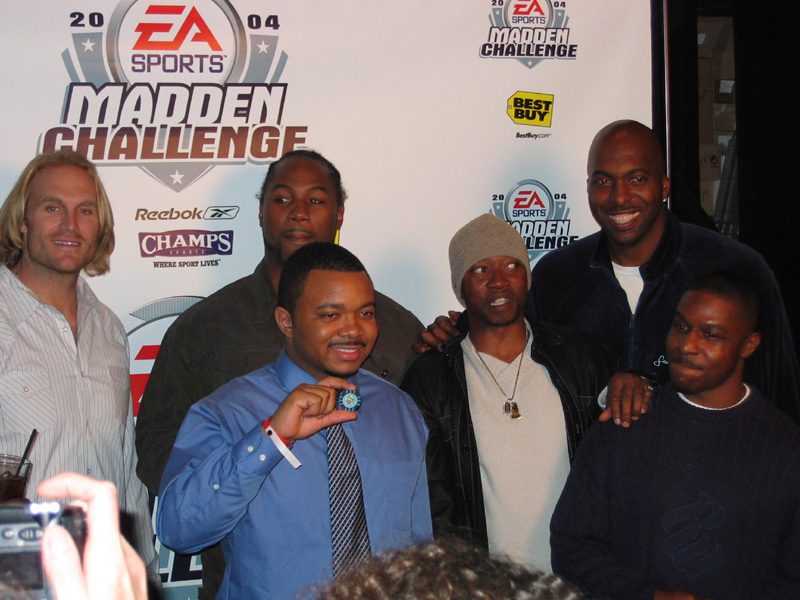Madden Challenge Finals Recap
GameSpot Sports is there for the finals in the 2004 Madden Challenge Tournament. Find out who takes home the title, and the $50,000 prize, inside!
What would you do in Las Vegas with an extra $50,000? That was the question 32 of the best Madden NFL 2005 players in the country were asking themselves last Saturday just before the opening rounds of the 2004 Madden Challenge Finals event, which was held at the Mandalay Bay Casino. The finalists, all winners from the 32 regional events held during the Madden Challenge road tour, convened at the casino to determine who would take home the title as best Madden player of the year, along with a debit card worth 50 grand.
The stage was set early for intense competition, as this year's list of hopefuls included some familiar faces, such as last year's Madden Challenge winner David "Sandman" Sietchick and runner-up Eugene "Big Gene" Williams, in addition to another former finalist in David "Dred" Grant. Many of the finalists had played one another before, either in this year's slate of regional tournaments or in previous years' events. It wasn't unusual for players to compete in several regional tournaments, often hundreds of miles apart from one another, in hopes of nailing that shot at the finals in Las Vegas.

The evening before the actual tournament began, a celebrity pro-am event was held at a casino nightclub, where current and former pro athletes such as Kyle Turley, Ray Mickens, Bryan Cox, and John Salley took on the Madden Challenge finalists in a friendly tournament. Just who the "pros" and "amateurs" were was up for some debate, however, as the majority of the stars were eliminated early, including Turley, Cox, and Salley. Mickens, a former Madden Bowl winner, was clearly the best gamer among his celebrity colleagues, even though he was beaten in overtime by Madden Challenge finalist Anthony "Booker T" Mims.
The real competition, however, began the following morning when players arrived at 9am to begin the long day of tournament games. Along with the Madden finalists, the concurrent 2004 NCAA Football Finals were also held, pitting 16 of the best NCAA Football 2005 players in the country against one another, all vying for a championship title and a $10,000 pot. Perhaps due to the smaller prize or because of the relative lack of hype surrounding the NCAA event, the generally mellow, competitive vibe between the NCAA tournament finalists was in stark contrast to the trash talking and dog barking that ran rampant through the Madden tournament.

Just as we saw in the San Francisco regional tournament held several weeks prior to the finals, the best Madden players know that to win you need to have the best weapons in your arsenal. As such, the vast majority of players preferred one of two high-powered offensive teams for the tournament in either the Atlanta Falcons or the overwhelming favorite Minnesota Vikings. A scattered few chose such teams as the Tennessee Titans or the Denver Broncos. Interestingly, one poor soul even chose the Washington Redskins...and was promptly eliminated early in the competition.
A Common Approach
This all-offense, all-the-time approach resulted in some huge scores, even in games comprising four-minute quarters. Touchdowns off of huge plays were commonplace, and the number of punts during the entire tournament could probably be counted on two hands. As the tournament continued over the course of the day, it became clear that the best players weren't necessarily the best or most knowledgeable football players. Rather, they were the most skilled at taking advantage of some of the inherent features found in this year's Madden game. Some of the most commonly seen tactics:
- Running sweep plays to one side of the field and then, using the game's "juke" controls, quickly moving the runner back to the opposite side of the field. This move, when used against less skilled defensive players, seemed to fool the defensive line far too easily and opened up huge runs along the sidelines on that opposite side of the field.
- When in the right hands, juke moves in general were incredibly effective. It was common to see players stutter-stepping their ways through dense defensive traffic while causing AI-controlled misses to the left and right. The juke move also had a more practical use: It was an easy and effective method for avoiding dive-happy user-controlled defensive players.
- One of the most effective passing strategies involved the so-called "strafe catch." By sending a tall tight end toward a sideline and then tossing a pass his way, a player could use the strafe-catching feature to position his pass in such a way that only his receiver was in a position to catch the ball. If the tight end missed the pass, more often than not the ball would head out of bounds, thus allowing no opportunity for an interception.
- Hot routes were both plentiful and called at a blinding rate before almost every play in every game. If you could pay attention to the quick pace of the playcalls, you'd see that nearly every receiver on the field was hot-routed to a different assignment before the snap. The most interesting aspect, however, was that most players used only a handful of plays in a single game, choosing to instead mix things up at the line of scrimmage rather than scroll through play sets in the playcalling screen.

The final match of the day was between last year's runner-up Eugene "Big Gene" Williams and New Orleans regional winner Antoine "Pretty Boy" Williams. In effect, it was a matchup of two entirely disparate styles: the complete player versus the specialist. All day, Big Gene had shown a propensity for employing a strong passing game that featured heavy use of Atlanta Falcons players Michael Vick and Brian Finneran, as well as the strafe catch feature described above. What set Big Gene apart, however, was his deadly effectiveness on the defensive side of the ball. He was one of the few players in the tournament who consistently knocked down or picked off passes with his user-controlled defensive backs. Pretty Boy, on the other hand, had one main weapon in his football arsenal, and he used it to lethal effect: the juke move. Throughout the day, Pretty Boy used his skill with the running game to score touchdowns at will, often going untouched into the end zone.
The excitement of the final game of the tournament was marred briefly by a rules dispute involving an alleged illegal substitution made by Pretty Boy Williams, who had just scored a passing touchdown with Vikings' receiver Michael Bennett. After about 15 minutes of deliberation, during which both finalists were led offstage, a ruling was handed down from tournament officials: Williams' touchdown would be stricken from the record because of his illegal substitution, and the game would be reset to conditions just before his most recent drive. This decision met with some contention, mostly from Pretty Boy himself, who claimed that he'd been allowed to play with this roster setup throughout the day and was only now penalized during the finals.
Despite the controversy, Eugene Williams prevailed over Antoine Williams in a 37-27 game. Big Gene's victory provided him with consolation after his disappointing second-place finish in 2003. Meanwhile, Jesse Hanninen, a 20-year-old junior from Florida State University, triumphed in convincing fashion with a 25-6 victory to take home the $10,000 prize in the 2004 NCAA Football Challenge finals.
The main question on everyone's mind at the beginning of the tournament--"What would you do in Vegas with an extra $50,000?"--sadly remained unanswered, as the debit card (in Big Gene's case) and the check (in Hanninen's case) would both be activated once the winners left the city, and temptation, behind.
Got a news tip or want to contact us directly? Email news@gamespot.com
Join the conversation